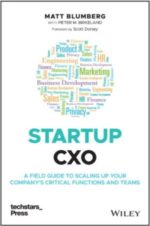I wrote a colorfully-named post years ago called Onboarding vs. Waterboarding, which detailed out some of the general principles around onboarding new employees that our companies have used over the years. A few weeks back, one of our clients and fellow CEOs of a Series C Ed:Tech company asked me for tips on onboarding senior executives, and some of what I said varied from or built on that earlier post. Here are a few of the themes we riffed on: Special thanks to my friend Amir for inspiring this post!
Category
Leadership
What Does Great Look Like in a Chief People Officer?
This is the second post in the series…. the first one When to hire your first Chief People Officer is here). While all CXOs are important to a company, the Chief People Officer is the one role you don’t want to get wrong because People Ops impacts every facet of a company. If you hire the wrong people—even one wrong person—you’ll regret it, and so will everyone else in your company. If you short-change the onboarding process you’ll create tons of work for others in the company to answer questions, teach people the systems, and help them get up to speed quickly—not to mention the frustration of the new hire. And of course, if you or your employees do anything…
Should CEOs Wade Into Politics, Part II
I’m fascinated with this topic and how it’s evolving in society. In Part I, a couple years ago now, I changed my long-held point of view from “CEOs should only wade into politics when there’s a direct impact on their business” (things like taxes and specific regulations, legal immigration) — to believing that CEOs can/should wade into politics when there’s an indirect impact on business. In that post, I defined my new line/scope as being one that includes the health and functioning of our democracy, which you can tie to business interests in so many ways, not the least of which this week is the Fitch downgrade of the US credit rating over governance concerns. Other CEOs will have other…
When to Hire Your First Chief People Officer
(Post 1 of 4 in the series of Scaling CPO’s) In most startups, the HR function starts out as tactical, because you have to get people hired and paid, and while you might have a founder or early-stage employee who can do these things, often these tasks are frequently outsourced to a PEO. As the company grows, it probably in-sources payroll and benefits, hires a recruiter, and maybe has an HR Manager who handles the function. Depending on the number of roles you see being filled, the degree of specialization, or a host of other factors, an in-house team to handle the tactical aspects of HR makes a lot of sense. But at some point you may need to hire…
Formula for Strategic Leadership
Years ago, I heard then General David Petraeus give a talk to a small group of us about leadership. He was literally coming to us live from his command center in Iraq or Afghanistan when he was running the whole theater of war over there. I realize he subsequently had some tarnish on his reputation after pleading guilty to a misdemeanor around handling classified information, but the main thrust of his talk, his Formula for Strategic Leadership, still stands as one of the more memorable talks on leadership I’ve ever heard and is no less relevant as a result. Given that I still remember it vividly 14-15 years later, I thought I’d recreate it here with my own annotations after…
How I engage with the Chief Privacy Officer
Post 4 of 4 in the series of Scaling CPO’s- the other posts are, When to Hire your First Chief Privacy Officer, What does Great Look like in a Chief Privacy Officer and Signs your Chief Privacy Officer isn’t Scaling. There are a few high-quality ways I’ve typically spent the most time or gotten the most value out of Chief Privacy Officers over the years. Part of it may have to do with the business we were in at Return Path (and now, Bolster), but part of it is understanding what the Chief Privacy Officer needs from the business and working with them in that arena. For example, I found it helpful to work with the Chief Privacy Officer to…
Learning Loops
The last couple weeks, I’ve written about tools in the CEO toolbelt that I learned with my coach Marc years ago in a workshop called Action/Design — Inquiry vs. Advocacy, and The Ladder of Inference. The final post in this series is about Learning Loops (or Double Loop Learning if you prefer), popularized by Chris Argyris a couple decades ago. Here’s the graphic on it: What’s the tool in the CEO toolbelt here? It’s that every time you’re analyzing a result, you need to analyze it on two levels. Level 1 is the more obvious learning — “What happened…and what do I do next time to produce the same/a different result?” Level 2 is the less obvious learning — “Why…
Signs your Chief Privacy Officer isn’t Scaling
This is the third post in the series. The first one When to hire your first CPO is here and What does Great Look Like in a CPO is here). Chief Privacy Officers who aren’t scaling well past the startup stage are the ones who typically have the following characteristics and you should look for some of these telltale signs. First, if your Chief Privacy Officer looks at you sideways when you ask for a strategy or even a mitigation plan for a breach, then you might have a bigger problem than the fact that you don’t have a plan. While we like to talk about things like Privacy by Design and using data protection as an offensive strategic weapon,…
The Ladder of Inference
Last week, I wrote about Inquiry vs. Advocacy, an important principle I learned early in life and then explored more deeply in an Action/Design workshop my coach Marc took our whole leadership team through years ago. This week, I’ll continue to riff on the theme of communications tools in the CEO toolbelt by talking about The Ladder of Inference (detailed article here). This is a great graphic from the article: Any time you’re struggling with opinions vs. opinions or people are jumping to conclusions based on a narrow set of evidence, this framework is your friend. The best way to start any tricky conversation with those characteristics is to start “at the bottom of the ladder,” meaning you start by…
What Does Great look Like in a Chief Privacy Officer?
(This is the second post in the series… the first one When to Hire your first Chief Privacy Officer is here) Most Chief Privacy Officers are fairly specialized, often coming from a legal or law enforcement background, but regardless of background I’ve found that ideal startup Chief Privacy Officers do three things particularly well. First, a great Chief Privacy Officer will work to create educated evangelists inside the company. Our Privacy team at Return Path, under Dennis Dayman’s leadership, had a lot of experience and industry certifications, but that experience was not something only for regulators and other companies, or only bragging rights within their team. They also took the time to make sure others in the company, especially in…
Inquiry vs. Advocacy
My Grandpa Bill used to not want to talk about himself at dinner parties. When one of us asked him why one day, he said, “I already know what I have to say. What I don’t know, is what the other person has to say.” There are a few principles I learned years ago in a workshop that my coach Marc led for us called Action/Design. I’m going to try writing a few posts about them, and you can find some articles on them here. Inquiry vs. Advocacy is simple. Understand the balance of when you ask and listen vs. when you speak in a given conversation. Both are important tools in the CEO tool belt. My rule of thumb…



